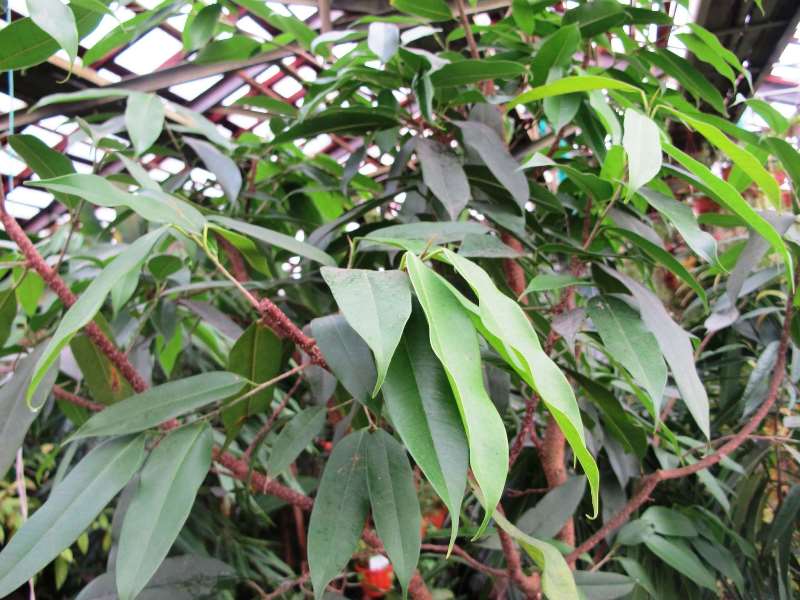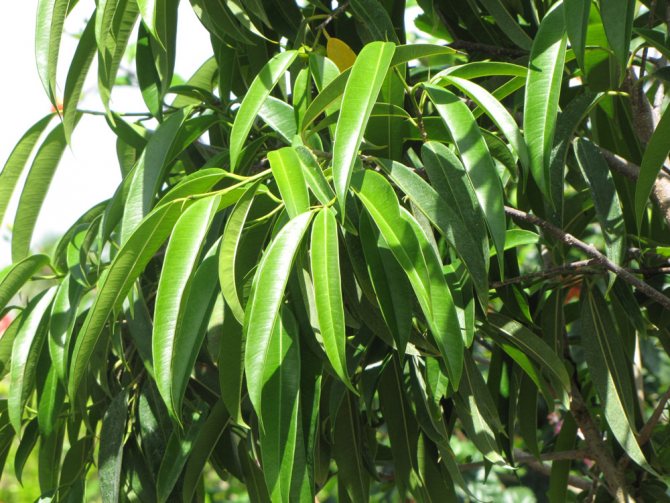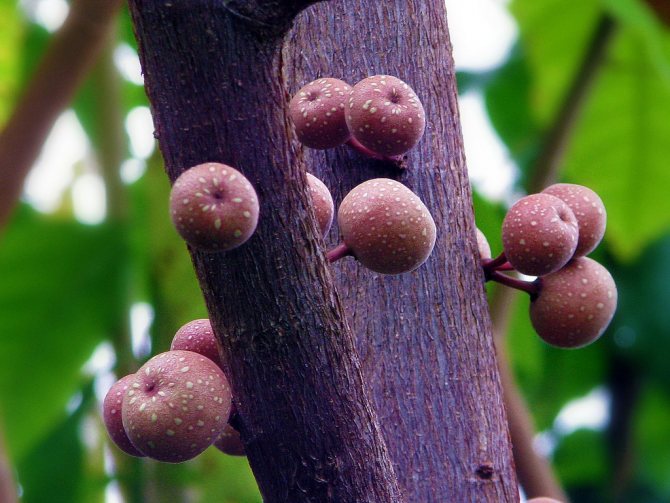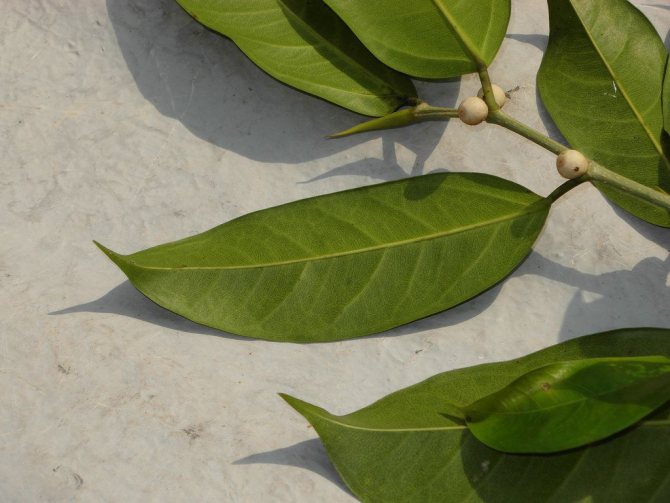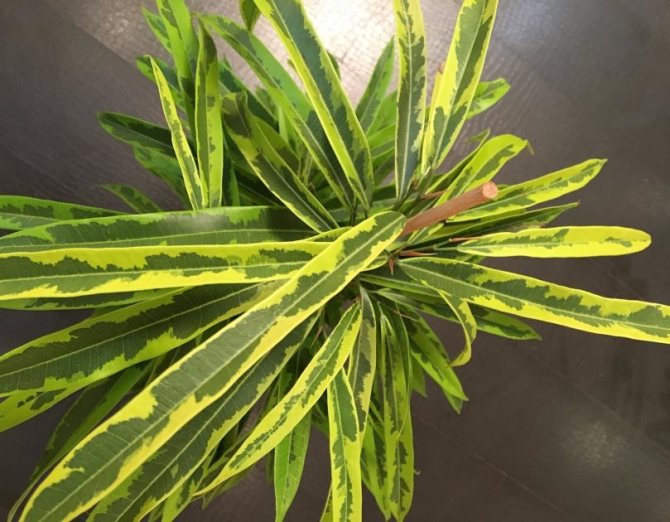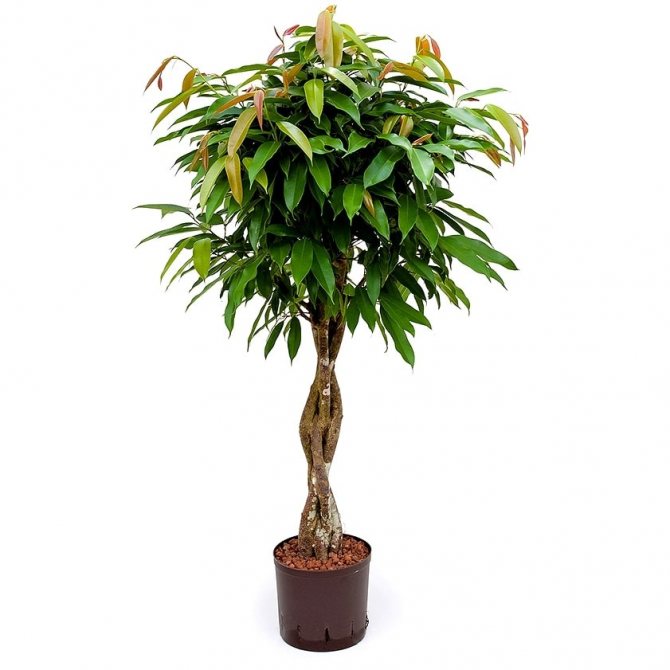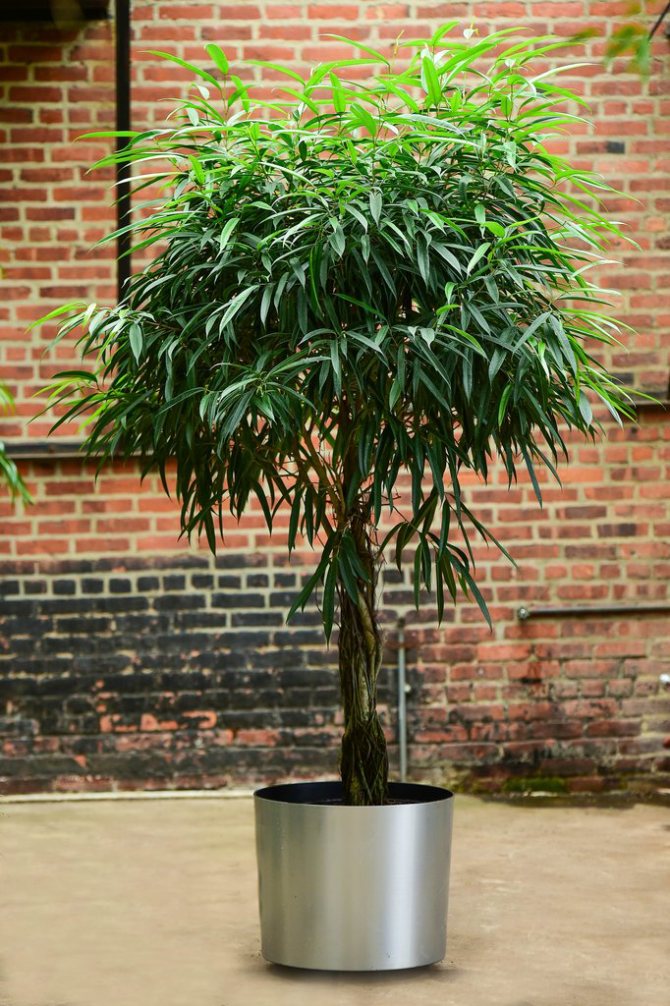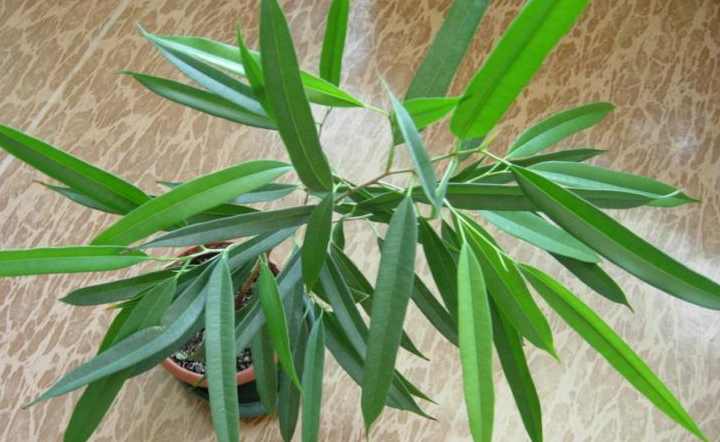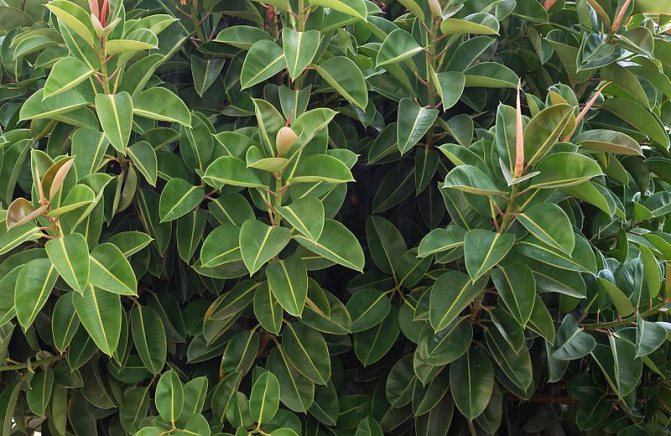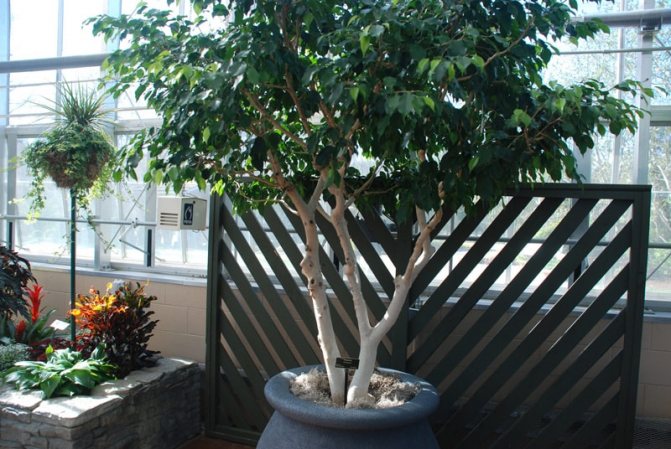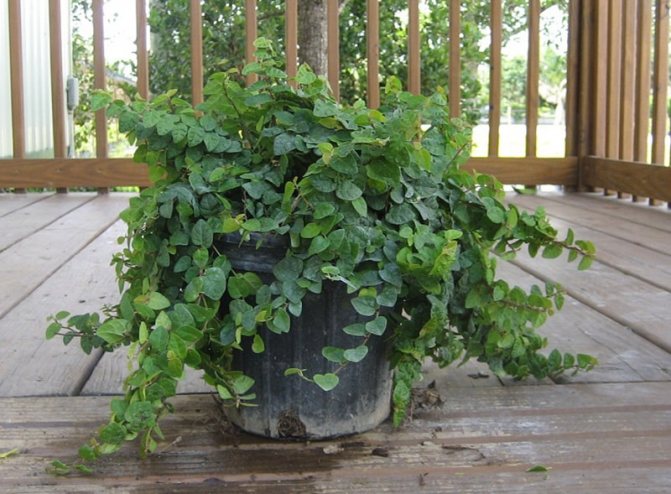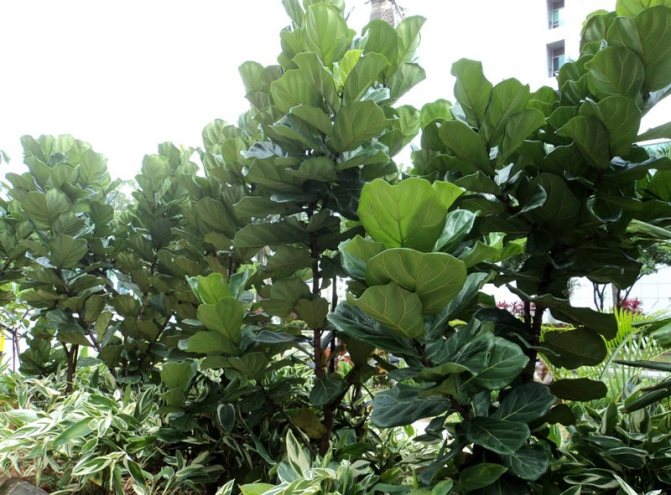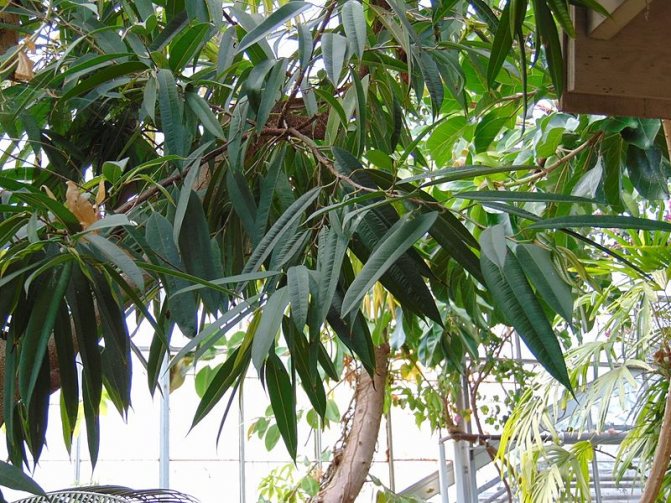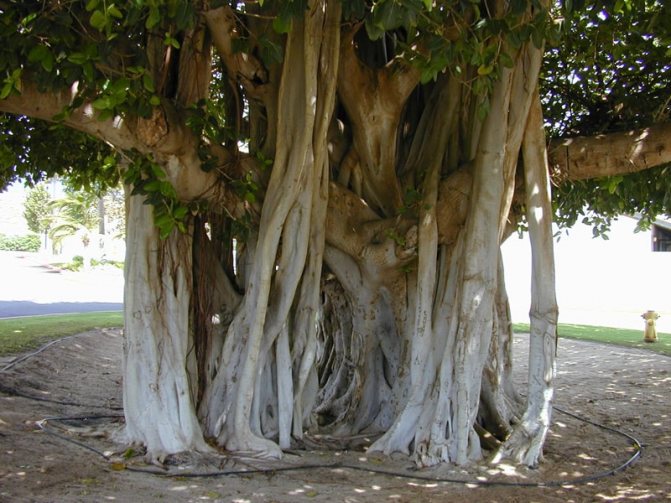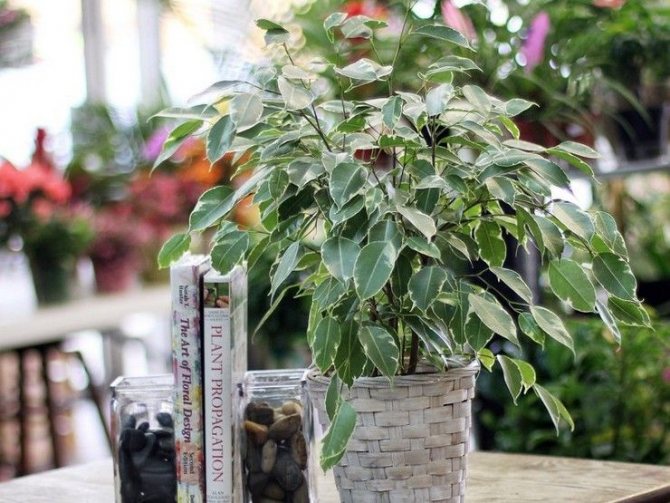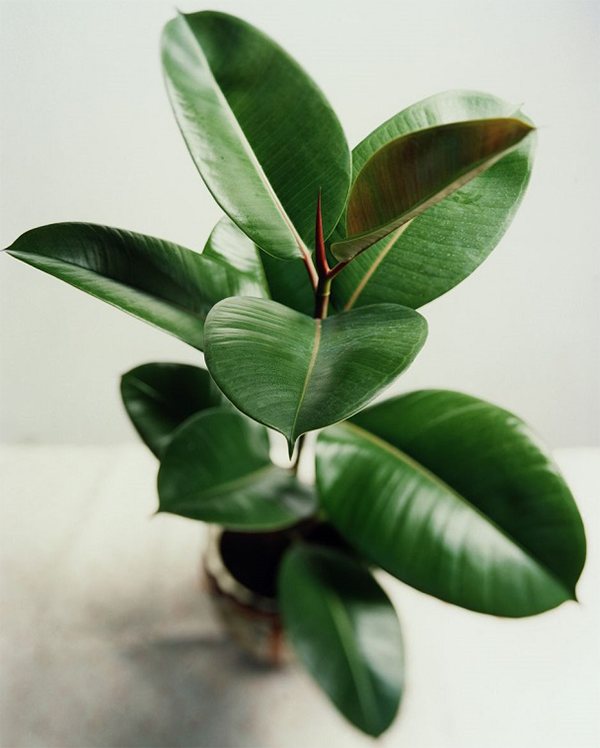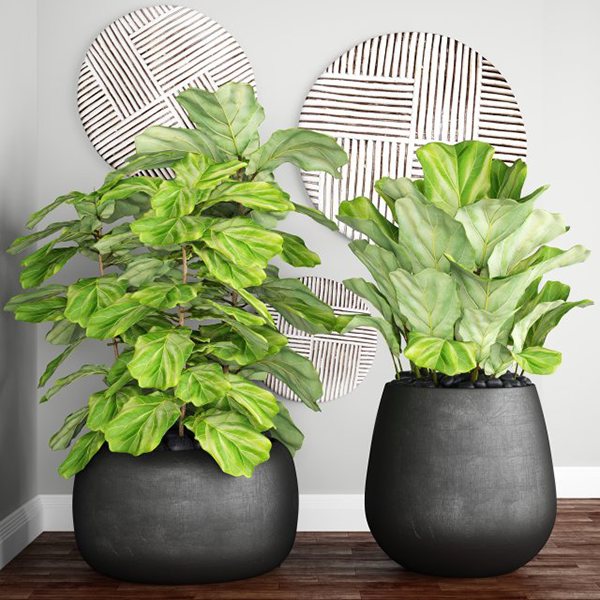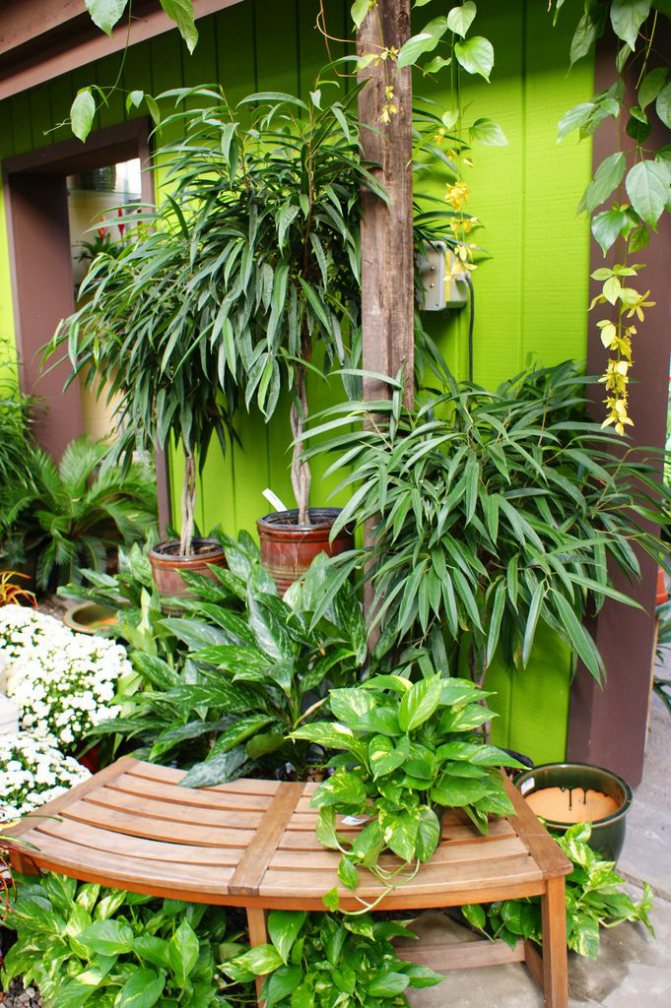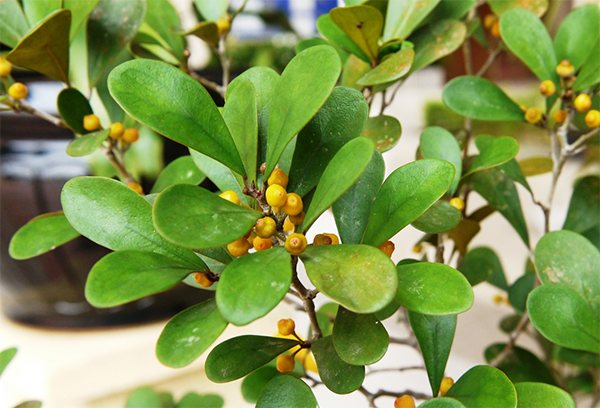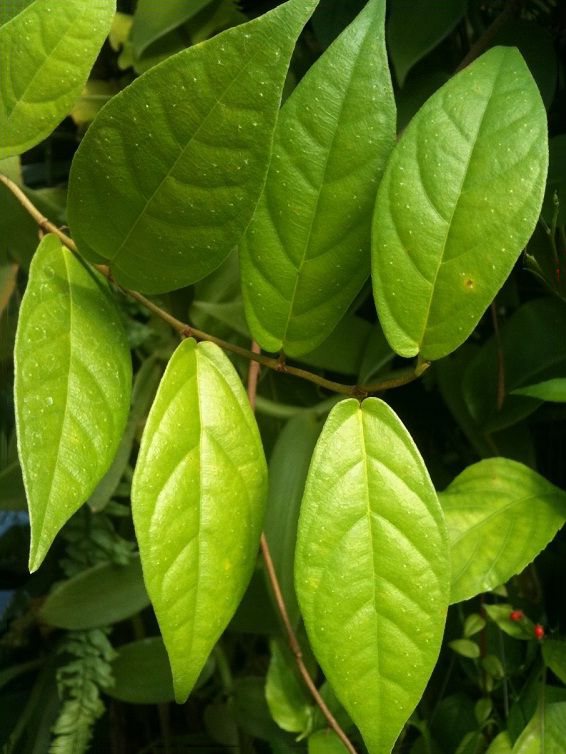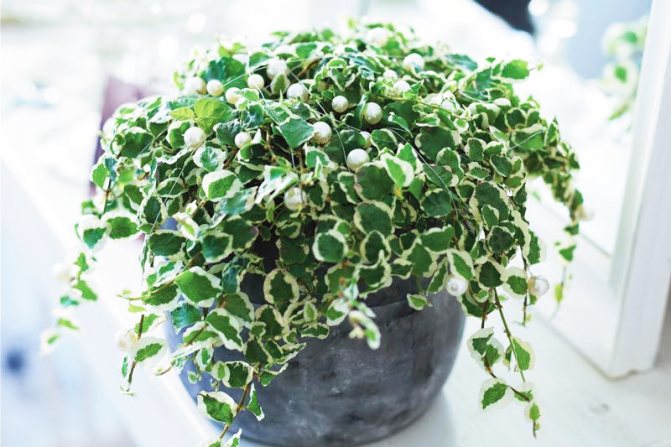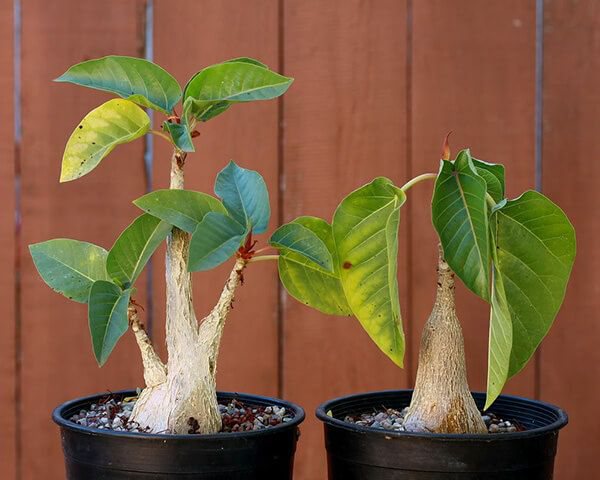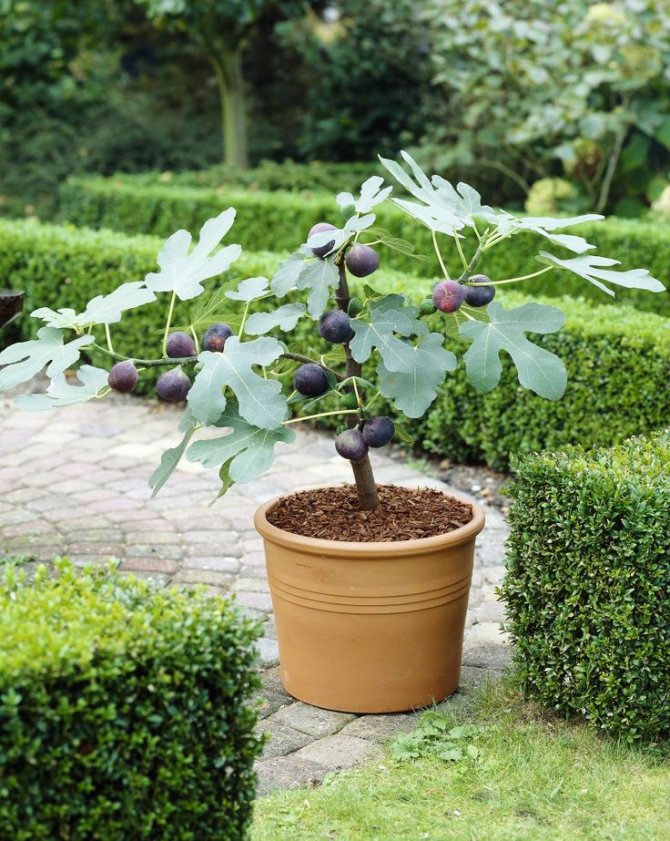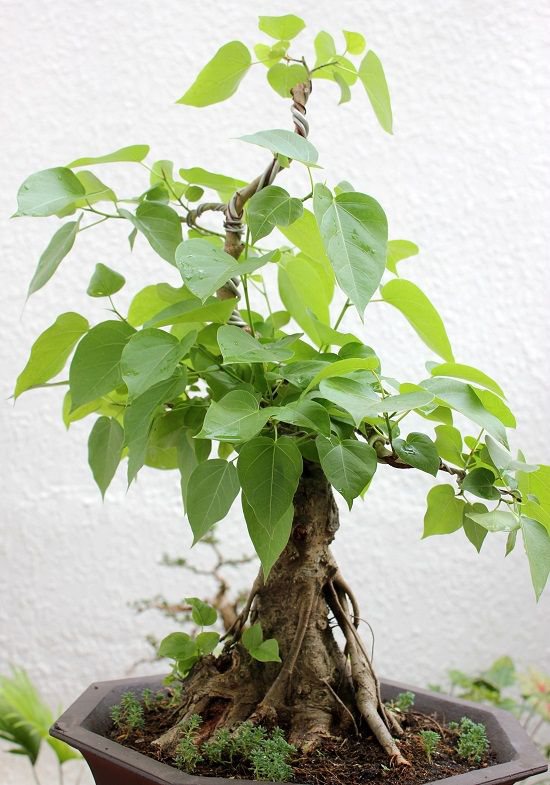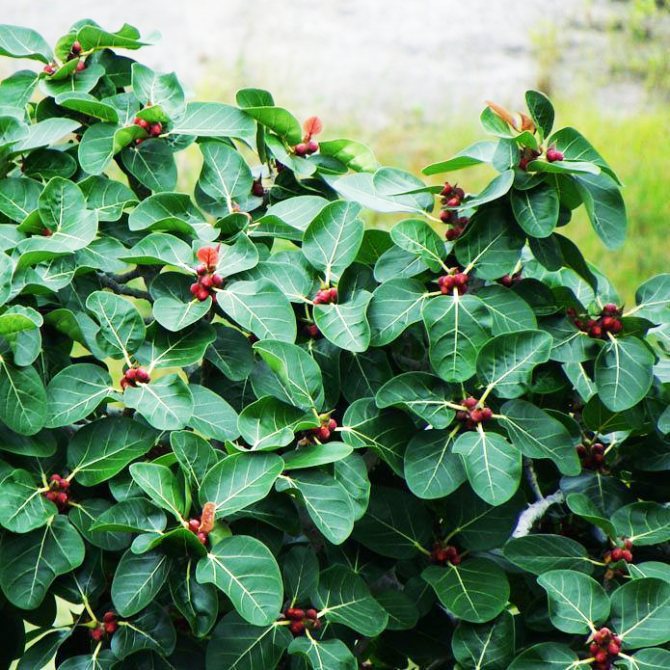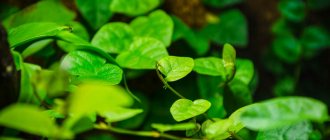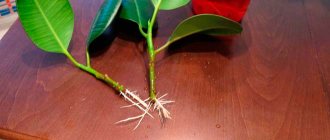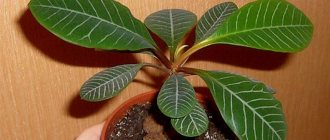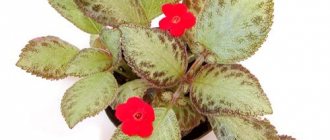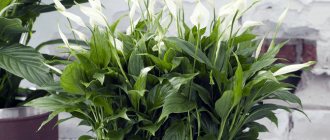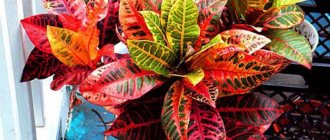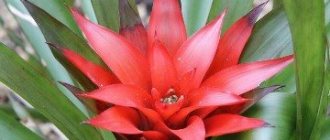Ficus Ali is a great opportunity to get a mini-copy of a willow at home. Only the tree usually needs high moisture for normal development. And caring for ficuses is extremely simple, not requiring much time and effort. In addition, it is believed that these plants have positive energy and promise financial well-being to their owners.

"Room willow"
Characteristic
The plant has several varieties. Outwardly, they all differ from the usual ficus. This is especially true of the crown. Unpretentious in breeding and care.
In the wild, the ficus benedict Ali grows up to 15-20 meters. The trunk is tree-like, distinctly flat in the lower part, not branched. Thin branches... Closer to the top, they bend slightly downward.
The leaves are slightly widened over the entire area - about 5 cm, rather long with pointed tips. Sometimes the size of the sheet reaches 30 cm in length... Their color depends on the place of growth and on the variety. It can be variegated or monochromatic.
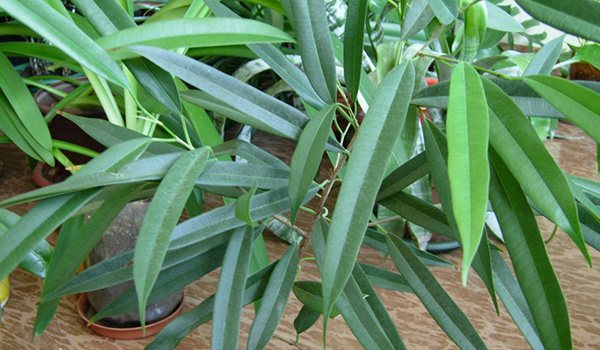

Most adult specimens that are bred at home have dark green foliage with streaks of light green tones. Branching veins running along the entire surface are often clearly visible on the leaf. Central the vein visually separates the leaf in half, while giving it a curved shape.
Soil, watering and feeding
The soil for the "home willow" should be loose and fertile. If possible, you can mix peat soil, turf, sand and charcoal at home. Or you can purchase a suitable composition in the store. Or you can buy nutritious soil and mix it with sand - this option is quite acceptable for ficus. Only when planting on the bottom of the pot should be sure to pour a layer of drainage, this will prevent rotting of the plant roots.
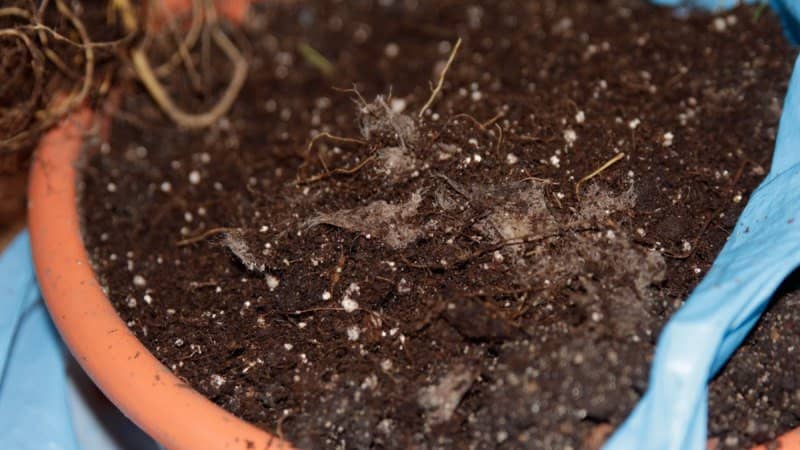

Soil for indoor plants
On the one hand, this type of indoor flowers does not like a long absence of water, but excessive watering can be destructive. Ficus should be watered as follows (water should be at room temperature):
- in summer - about three times a week, when the top layer of the earth becomes dry;
- in winter - about once a week.
You should focus on the general condition of the flowers. If the plant sheds leaves or they begin to dry out, then it may be necessary to increase the frequency of watering. In the event that the leaves turn brown and soft, this may indicate the beginning of decay of the plant. Here you should remove the ficus from the pot and examine the roots. If there are rotten ones, they must be removed. Further, the entire root system should be rinsed in water with potassium permanganate and the flower should be planted back. In the future, the amount of water and the frequency of irrigation must be reduced.
Ficus Ali is a big lover of humid air, which can be easily ensured by periodically spraying the leaves. Moreover, this should be done in intense heat. Young plants can be bathed in the shower, having previously protected the soil from erosion.
Fertilizer should be given to the plant during the period when it begins its active growth - March – October. In addition, ficuses need feeding after transplanting and after pruning.As an additional nutrition, a universal fertilizer is suitable, which can be purchased at any gardening store.
This is the basic care that must be provided to the ficus at home. Following these simple rules will help you grow a healthy and strong plant without much hassle.
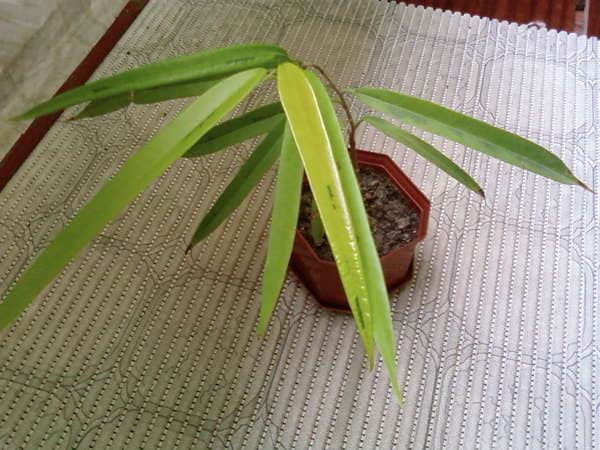

Ficus Ali leaves withering
Main varieties
Ficus binnendijka has a lot of derived varieties. All of them are unique in their own way.
Today we will consider only the most popular among florists.
Ficus Ali
More often than others, you can meet him in the arrangement of interiors... Its leaf plates have slight differences from other varieties due to a slightly increased leaf width. This gives the ficus a certain grace, which breeders are willing to use. for decorating building facades and premises;
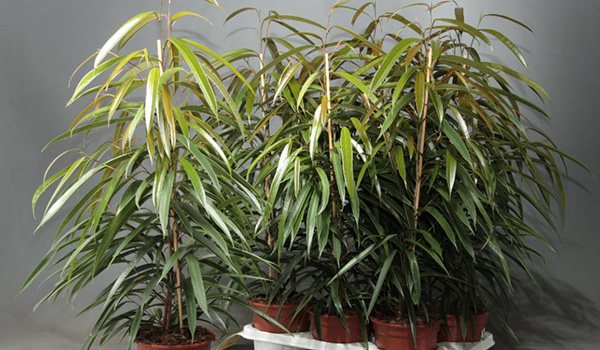

Amstel King
It has advantages due to unpretentious care... Externally original. Leaves can be up to 8 cm wide. Slightly wavy, shiny. In a young plant soft brown bark, and in an adult it is silvery;
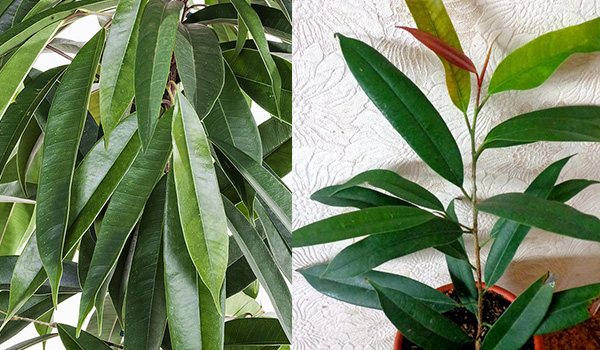

Amstel Gold
It is also called "green gold". The name itself calls for the acquisition of this particular owner is incredible rich gilded colors... The leaf plates have an unusual and very beautiful color, which suggests the presence of green-yellow pigmentation at the base of each leaf.
And its entire surface is covered with multiple inclusions shades of green in different shapes... Unusual and sophisticated decoration of any room;
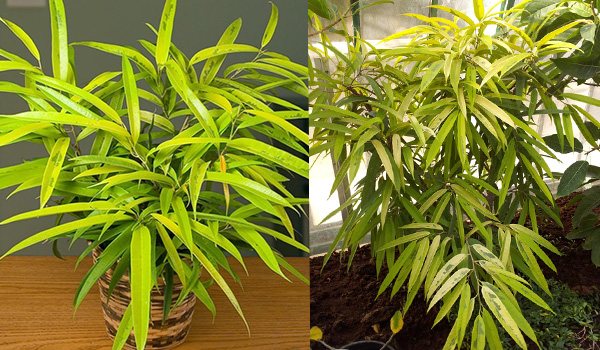

Amstel Queen
A variety with an intermediate width of the leaf plate, the owner of an incredible and noble color. This ficus amazes with splendor... It will bring color to the interior and become a unique decoration.
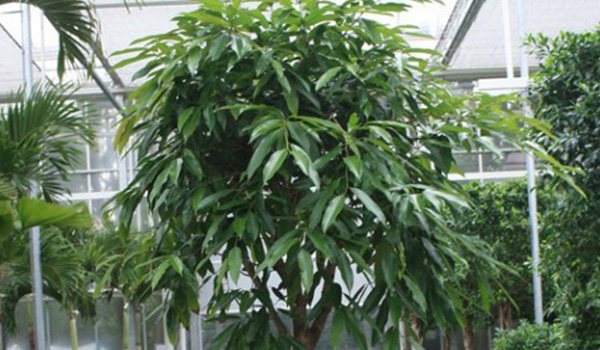

Protection against diseases and pests
Your pet may be exposed to the adverse effects of various diseases due to improper care. Also, if you do not follow all the necessary conditions, there is a chance to find harmful insects on the leaves of the flower. Therefore, proper care is the best protection and prevention of various pests.
- For example, if you take care of a flower incorrectly, a mealybug may appear. It is removed either mechanically or using a very weak alcohol solution.
- If your pet is attacked by scabbards, use soapy water or (if the process has gone too far) use insecticides.
- They get rid of the spider mite, creating a kind of greenhouse effect. If the desired result does not come, use an insecticide.
Remember that insecticides are toxic, so take care of yourself.
Home care
Lighting
The plant is light-loving. Feels good in diffused lighting in conditions of sufficient brightness... Varieties with variegated deciduous color require more light.
Holders of a monochromatic crown can grow quietly in partial shade.
Important! It is advisable to place the culture on the east, southeast side. It is difficult to endure drafts, as well as a sharp change in the situation, temperature.
Air temperature
It grows and develops better while maintaining the temperature regime in the area 22-24 degrees Celsius... In winter, a decrease to + 16 ° C is permissible. It is not necessary to place a flowerpot with a flower in a cold period on windows or in other placeswhere the soil will be very hypothermic.
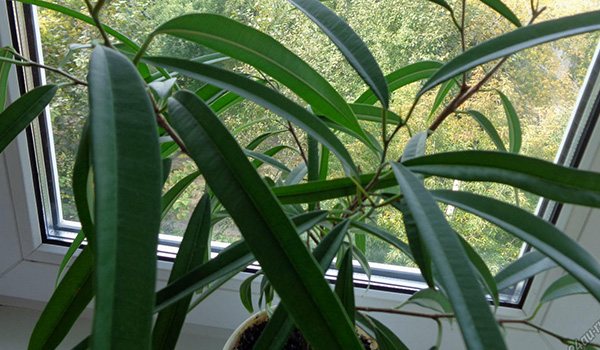

This will lead to a significant decrease in rhizome temperature. What the ficus can react to shedding foliage, the appearance of diseases. Due to the need to maintain good air circulation where the ficus grows, it is not recommended to place the plant next to heaters, batteries.
Excessive overheating can cause the development of diseases and even death indoor flower.
Air humidity
This indicator is not significant for the development of the ficus benedict. Moderate to 70% is fine.With increased heat in summer, it is advisable to periodically spray the foliage. warm settled water.
This video tells about the ficus Ali and the features of caring for the plant.
Irrigation
The plant should be watered as the soil dries out... If you find that moisture has evaporated from the soil at a shallow depth, it's time to moisten the ground or add water to the sump.
Important! the stand under the flowerpot should be dry, since the flower absorbs as much moisture as it needs. The excess must be poured out. Failure to comply with this rule will gradually lead to root rot.
Ground requirements
You can buy ready-made soil for planting ficuses. Palm substrates are also suitable... If you prepare the mixture yourself, you should take into account the following proportions: sand, humus and peat - 1 part each; leaf and sod land - 2 parts each. For a young seedling, humus can be excluded and a substrate can be made from the same components, taken in equal proportions.
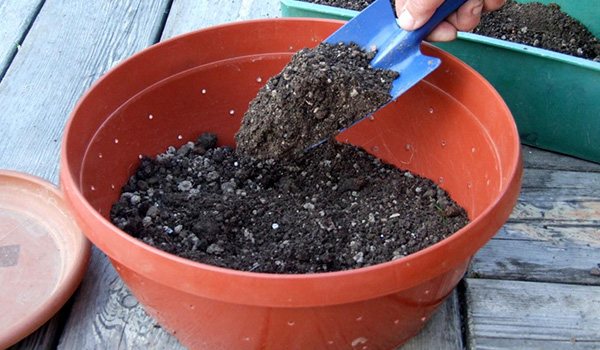

Top dressing
Fertilize the plant regularly. 1-2 times a week from spring to autumn... In this case, the introduction of organic substances with minerals should be alternated. Top dressing is applied exclusively to the ground. Some of its varieties can be dissolved in water for irrigation and fertilized simultaneously with moistening the soil by the same scheme no more than 1 time in 7-10 days.
Important! Since the dormant period for ficuses falls in the winter months, it is not necessary to fertilize the ficus at this time.
Crown formation
Ficus Ali is easy amenable to crown formation... You can independently create the volume and type of indoor plant that you like best. To do this, you just need to periodically trim the excess part of the branches. Then the crown will always be lush and compact.
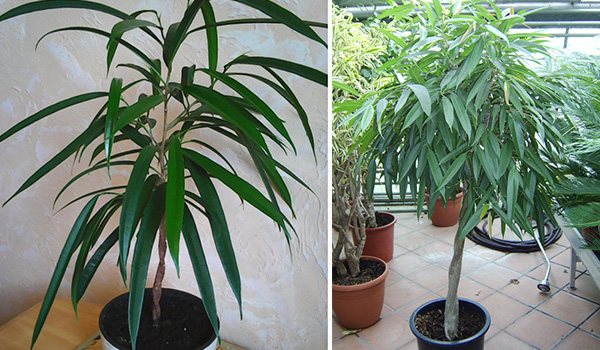

If you plant two young pagons in one pot and, in the process of their development, intertwine the trunks, you can grow an incredibly beautiful ornamental pigtail plant. This form of indoor culture will surprise anyone.
Lighting and warmth
All ficuses, including Benedict Ali's ficus, are warm and light-loving creatures. The air temperature should preferably be kept at +23 - +25 degrees. Such plants can live in the cool, but if the temperature is below +16 and the flower sheds its leaves, it is worth moving it to a warmer place. Exceeding the upper threshold threatens the ficus with drying out of the leaves. In this case, you will need to spray the plant, or place the pot in a container with wet gravel. In this way, it will be possible to compensate for the excessive dryness of the air. In addition, the plant should be protected from drafts and hot air currents.
Lighting for the ficus should be abundant, with shading from direct sunlight. These types of indoor plants are able to exist for some time with a lack of light. But, if the ficus drops its leaves and stops growing, then there is not enough light for it. Therefore, it is advisable not to allow finding flowers without access to the sun. In winter, for additional lighting, you can install fluorescent lamps or special lamps for seedlings next to the ficuses, which completely simulate sunlight.
But at temperature and light, plant care does not end. There are also other points, the observance of which is necessary for the ficus to develop normally at home.
Plant transplant
The transshipment of an adult plant, which is 5 or more years old, is carried out as the root system grows and the flowerpot becomes small... It will be sufficient to do this 2 times a year.
Young seedlings can change their pots once a year. Transplant best done in spring or summer during the period of active growth of the plant.
Advice! The plant should be transplanted into a container, the diameter of which is 2-3 centimeters larger from the previous one.
Transfer
For the transplant, a pot is selected, which will be only a little larger than the previous one.The flower should be very carefully removed from the pot (for this it is recommended to soak an earthen ball). Next, you need to separate the roots from the ground and carefully examine them. In the event that there are sick, rotten or dried roots, get rid of them immediately. After that, place the flower in a pot, add soil and water.
When the procedure is complete, do not touch your pet for a while. He needs peace to cope with stress.
Reproduction of ficus
Reproduction of this type of plant produced by cuttings... It is convenient to prepare them in the spring at the time of pruning, when the crown of the plant is formed. The stalk is rooted in water in good light premises.
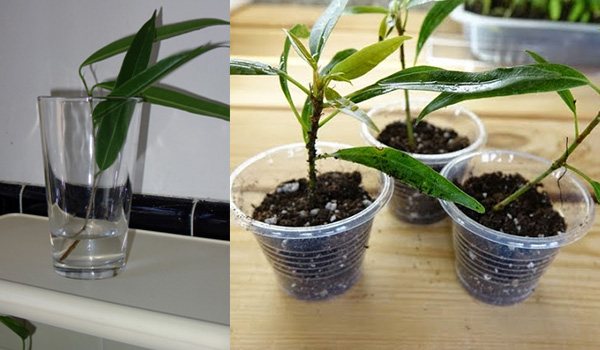

Observe a warm temperature regime and add water as it evaporates. Root can appear within 10-14 days... They are planted in a permanent place when the root is more than 2 cm.
The material should be planted in a nutritious soil, which must be pre-steamed. A similar procedure is required. If this is not done, then the seedling may not be accepted.
Reproduction
Reproduction of ficus Ali is a very simple process, it is very easy to carry out using cuttings. To reproduce this flower, it is necessary to cut off the stalk with a sharpened knife. After cutting, this part of the stem is placed in water and placed in a warm, bright place. Top up the water periodically, as it will evaporate rather quickly. After a while (about two weeks), small roots begin to appear at the cutting. Wait a little until they get stronger, and then plant the baby in a pre-prepared pot.
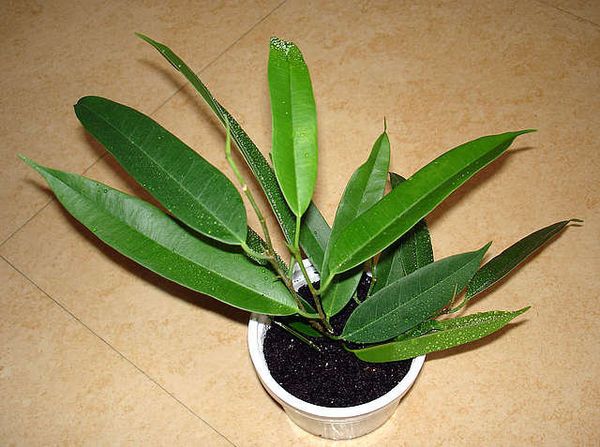

The best time to breed these flowers is late winter or early spring. It is during this period that their growth is activated, so by next winter your baby will be able to take root properly.
What kind of soil is needed?
The soil should be light, nutritious, moisture and air permeable and have a weak or neutral acidity (pH 5.5–6.5).
You can avoid stagnation of water in a flowerpot with the help of drainage from pebbles, expanded clay or broken brick at the bottom of the container.
Ready-made soil for palms and ficuses or soil mixture prepared independently from:
- sand;
- peat;
- humus;
- leafy land;
- turf.
To exclude the possibility of the presence of pathogenic bacteria and pests in the soil, before planting the Binnendijka, it must be sterilized by spilling it with a manganese solution or calcining it.
Expert opinion
Mokhov Andrey Petrovich
Graduated from KubSAU specialty: agronomy
The substrate for growing a young plant can only consist of peat, turf and sand.
Benefit and harm
Ficus Amstel King can absorb negative emotions. Feng shui experts and soothsayers attribute magical properties to it.
The plant is able to remove human anxiety, depression, routine, wheel of failure.
The dried leaves of the flower are used in aromatherapy, incense and incense.
Ficus smoke contributes to the enlightenment of consciousness.
The plant is often placed near a laptop and computer. He is able to purify the air and remove the wave radiation of technology.
Amstel King leaves are not recommended for nursing and pregnant women.
In case of contact with the eyes of the stem milk juice of the plant, it is necessary to thoroughly rinse it under running cold water.
The plant can cause allergic reactions.
Attention! If you feel worse after buying a flower, you need to get rid of it.
The presence of ficus in a home or office can radically transform the atmosphere, create coziness and establish a microclimate. Read about growing popular varieties such as Benjamina, Moklame, Small-leaved, Microcarpa, Large-leaved, Dwarf, Benedict, De Dumbbell, Retusa and Carica.
Pests. Table
| Pest | Signs | How to get rid of |
| Shields | The leaves turn pale, a sticky coating forms on them, after which they fall off | Treat the plant with soapy water and Aktellik |
| Spider mite | White dots and thin cobwebs can be seen on the leaves. | Rinse the ficus under the shower, cover with plastic and move to a warm place to create a high level of moisture that pests cannot tolerate. If this does not help, treatment with Fitoverm, Agravertin, Neoron or Sunmight will be required |
| Mealybug | A sticky discharge and a light bloom resembling wax appear on the foliage | Wipe the affected parts with a solution of alcohol and treat with "Aktara", "Confidor", "Tanrek" or "Calypso" |
Possible growing problems and diseases
Ficus Ali is rarely exposed to disease and pest attacks when properly cared for. Its owners may face the following problems:
- if the plant does not have enough light, it begins to shed foliage and slows down growth;
- drooping and thinning foliage indicates an excess of moisture;
- if the ficus is in direct sunlight, its leaves will begin to dry out and wrinkle;
- brown spots can indicate problems with fertilizer, temperature and dry air.
If the plant is not well looked after, it can be attacked by pests. Fortunately, they are easy to deal with. If a thin cobweb appears on a ficus, a spider mite has wound up on it. For treatment, you should rinse the plant under the shower (including branches). This pest does not tolerate high humidity. The procedure should be repeated weekly for a month.
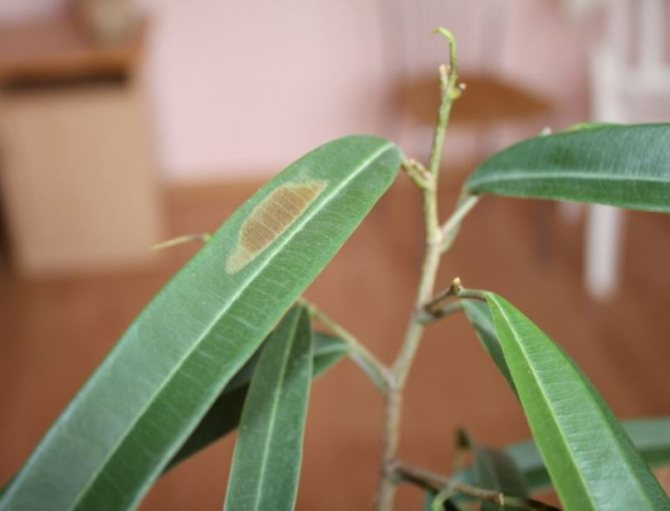

Affected plant (spots)
Ficus leaves can lose color and fall off when attacked by scabbard and false scabbard. These insects look like black blots, they are removed with soapy water, and a soft cloth is used to wipe them.
Origin story
The birthplace of the ficus Amstel King is the Indonesian island of Java. In nature reserves, it grows up to 20 meters.
Distributed in the Himalayan hills, Thailand, Philippines, Java, USA.
A young ficus has a dark brown bark, an adult has a silvery bark with small silvery stripes. The leaves are small, elongated.
In length they can reach up to 35 centimeters, in width - up to 8 centimeters.
On palpation, the leaves are shiny, wavy, drooping, looking down.
They have a sharp base and a petiole reaching 4 centimeters.
The leaf blades are curved along the main vein.
The main vein is distinct, located on the underside of the leaf. The lateral vein is faded.
Siconias are round or oval in shape. Reach in diameter 0.5-1.0 centimeters. They can be axillary, double or single.
At maturity, they reach a burgundy hue.
Why do flower growers like him so much
Ficus binnendiyka (or willow; less often the plant is called ficus Benedict, although this name is incorrect, since it refers to a completely different type of ficus) - a native of Southeast Asia. "In the wild" is a twenty-meter tree with drooping branches.
The leaves of such a ficus can be confused with willow or cherry. Depending on the species, their width and shade may differ slightly. In any case, there is a deep vein in the center of each leaf that turns the leaf into a small, half-open "booklet".
Ficus Ali is an ornamental-leaved plant, not whimsical at all. It grows quickly, in a couple of years of good care it can hit the ceiling.
And by the way! In vain superstitious people "run over" him. In narrow circles, ficus is known not as a bad plant, but as an energetically good plant. In particular, he helps his mistress to get pregnant quickly.
You can hear more about it here:
Photo
In the photo ficus "Amstel King":
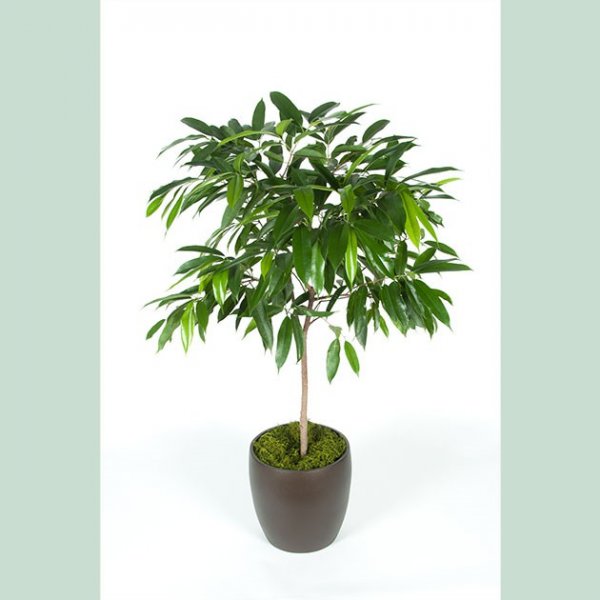

Description of ficus Ali
Ficus binnendiyka Ali in natural conditions can grow from fifteen to twenty meters in height. It has an even and long trunk, covered with strong dark bark. It is the same in indoor varieties, which, with good care, grow up to one and a half to two meters.The leaves are narrow, similar to dense straps, pointed at both ends, the branches droop beautifully, like a real willow.
The maximum length of the leaves is up to thirty centimeters, and the width is from 5 to 7. The leaf has a characteristic bright vein, and its color depends on the variety: there are both monochromatic and variegated specimens.


Types of ficuses
| Name, photo | Description |
| Ficus Benjamin (F. benjamina)
| The most popular tree variety is up to 2 meters tall with small leaves and drooping branches. The edges of the leaves can be either even or wavy, and the leaves themselves can curl. This species does not like to change its place of residence. Ficus Benjamin does not like both waterlogging and drying out of the soil. The plant tolerates shearing well, which allows it to form a crown of the desired shape. This variety is characterized by the formation of aerial roots, as they grow, beautiful weaves can be formed from them, which makes the tree even more decorative. |
| Ficus rubber (F. Elastica)
| The most common and unpretentious type of ficus. It cleans the air well in the room and saturates it with oxygen. This name is due to the fact that its milky juice contains rubber, which is used for the production of rubber. It is recommended to cut off the crown of an adult plant, then the plant will be more "lush". So that the ficus does not lose foliage, it is impossible to allow waterlogging of the soil, a sharp change in temperature, an excess of fertilizers. If the ficus likes the conditions, it will give 1 new leaf every week. In winter, a period of rest. Drizzle with warm water. |
| Ficus lyre (F. Lirata)
| A ficus leaf can grow up to 50 cm, therefore it has impressive dimensions and requires a lot of space. Loves diffused bright light and moderate temperature. In winter - cool content at a temperature of 12-15 °. We water it with warm water, but the ground should not be constantly wet; overdrying is required between waterings. The flower is transplanted when the pot is completely filled with the root system. |
| Ficus binnendijkii, or Ali (Ficus binnendijkii)
| The evergreen tree has long narrow drooping leaves and grows rather quickly. Ficus Ali is thermophilic and does not tolerate cold and drafts at all. You can propagate by cuttings, which take root without problems. |
| Ficus deltoid (variegated)
| An adult ficus grows as a lush bush with many aerial roots. In home care, ficus is thermophilic and loves spraying. Should be getting enough light. If he likes the conditions, it builds up a large mass of aerial roots. Often cultivated as bonsai. It is a slow-growing species. |
| Ampel ficuses | |
| Rooting ficus (Ficus radicans)
| The flower is very fond of warmth and water. Even short-term drying of the soil is unacceptable, the plant may die from this. This type of ficus also does not tolerate dry air. It is best kept in a small aquarium or greenhouse where humidity is easy to maintain. Does not tolerate the sun's rays. Grows well in bright ambient light or artificial light. |
| Dwarf ficus (Ficus pumila)
| Small-leaved ficus, which is also called tiny ficus. Can be grown as a creeping and climbing plant. Thin shoots can grow up to 5 meters in length. and grows to the soil with adventitious roots. The leaves grow in the form of 2.5 cm hearts with corrugated edges. The plant does not tolerate direct sun. Shoot growth is accelerated in a warm room with high humidity. |
| Bottle ficuses | |
| Ficus palmeri
| Differs in the original shape of the barrel in the form of a bottle. Such an unusual "design" is necessary for the plant in order to accumulate moisture and be able to withstand prolonged drought. In the spring, the transition to normal watering should be smooth. In summer, plants are watered abundantly, but not too often.A light-loving plant that tastes bright diffused light. |
| Ficuses - trees | |
| Fig (Ficus carica)
| Figs are also called fig, fig tree, wine berry. Has an edible fruit. The recommended temperature for germination of ficus seeds is 25 - 27 degrees. At the same time, daily ventilation and soil moistening are required as necessary by spraying. A plant grown from seeds bears fruit only for 4-5 years, in contrast to plants obtained by cuttings, which can begin to bear fruit in the second year. Fig is a light-loving plant. |
| Ficus sacred or religious (Ficus religiosa)
| The most famous ancient specimen is supposedly about 3 thousand years old. In nature, it grows up to 30 meters and, with age, grows overgrown with aerial roots that form supports. It is deciduous. In culture, it can hardly tolerate dry air and heat. Can shed leaves in such conditions. The sacred ficus is able to predict weather changes, forming droplets of moisture on the leaves when the atmospheric pressure changes. |
| Bengal ficus (Ficus benghalensis)
| The tree is constantly expanding in breadth, constantly forming additional trunks. When kept indoors, the growth of a banyan tree must be inhibited by periodic pruning and keeping in a cramped pot. It can propagate by cuttings and air layers. Dislikes temperature changes and drafts. Watering is plentiful and regular in all seasons, since this ficus does not have a period of weakening growth. |
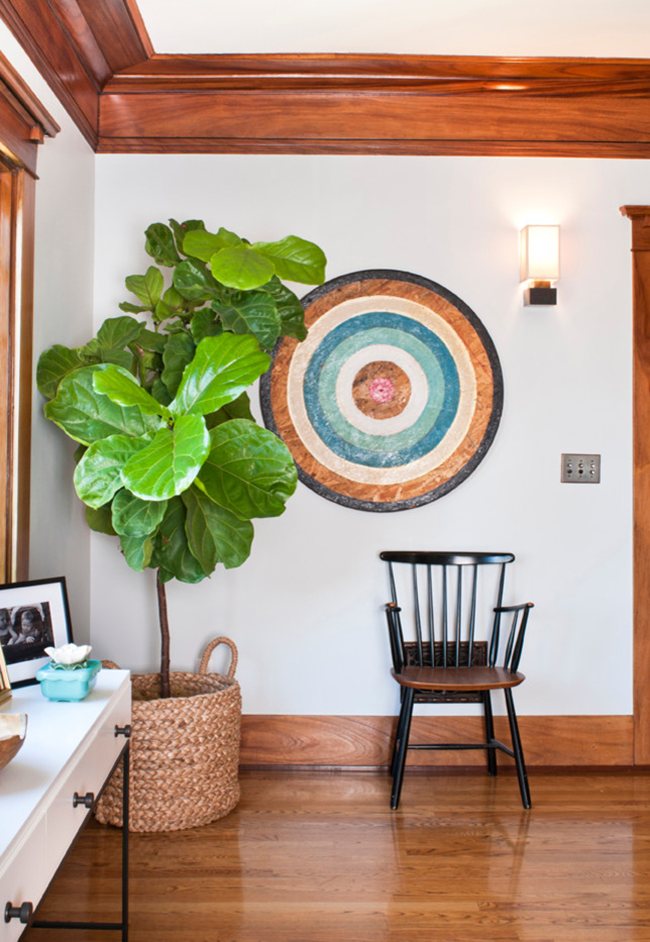

Lyre ficus is a favorite of flower growers. It has the largest leaves of all popular varieties.
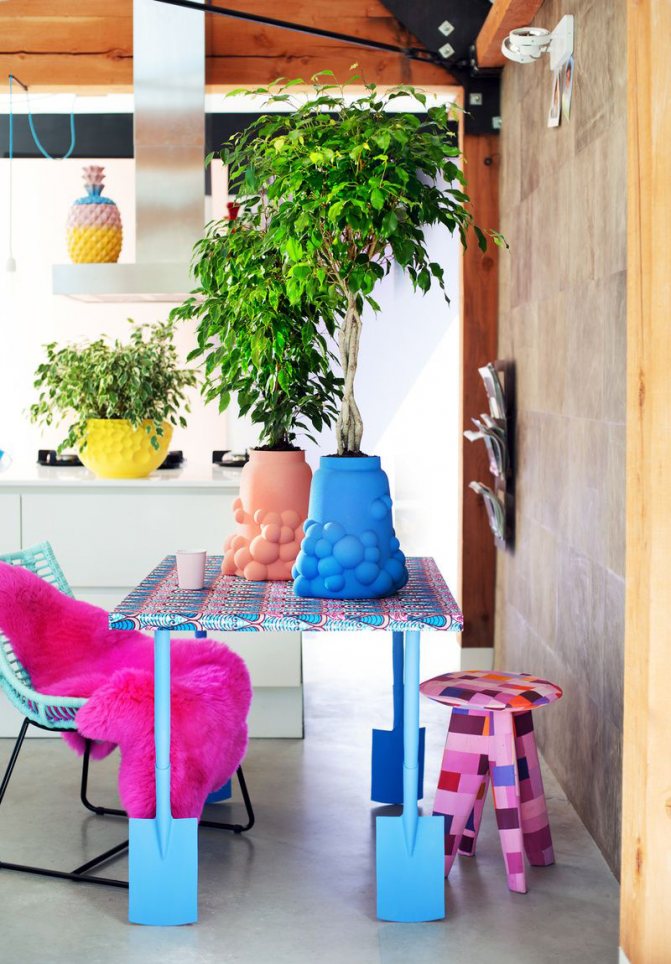

A tall ornamental plant is a great way to landscaping an interior.
In total, about 40 species of ficuses are known in culture, of which the most widespread in recent years has received ficus benjamin and its variegated hybrids, although it is not easy to grow, as it reacts capriciously to any trouble, completely shedding its foliage. However, there are several types of ficuses that are no less decorative, but at the same time much more unpretentious in care.
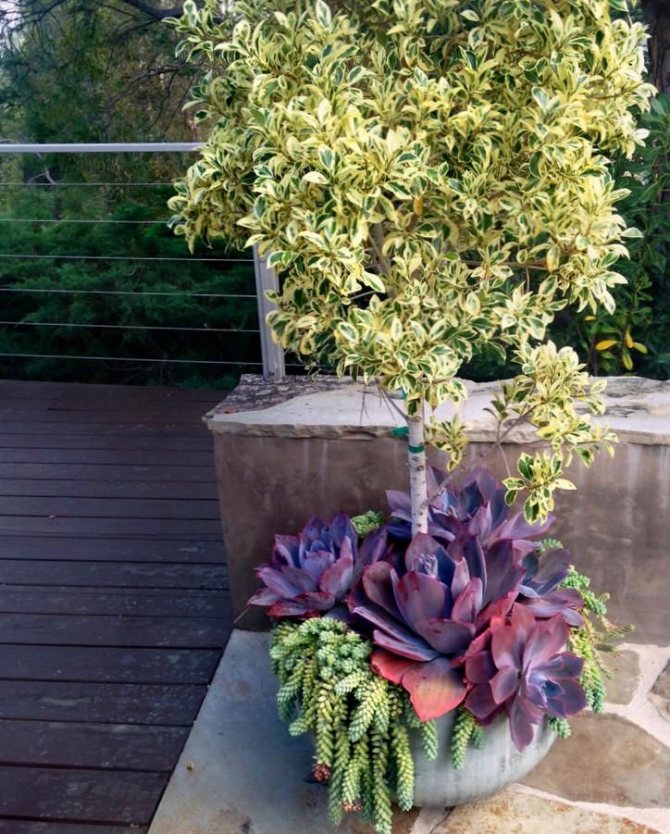

One of the hybrids of the ficus Benjamin
Flowering time
In nature, ficuses bloom... They have male and female flowers that are small, not decorative. Often they do not look like flowers, but resemble growths on the trunk.
Ficuses do not bloom at home.... The only exceptions are two types of ficuses - caricum and variegated. But even this lacks pollinating insects for setting seeds.
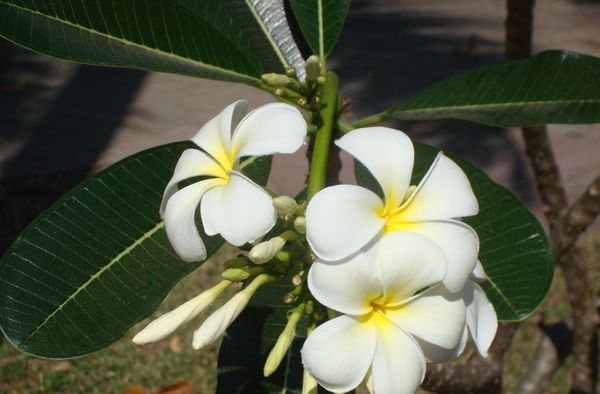

Ficus can bloom in nature
Growing conditions
Ficuses are not particularly demanding in terms of living conditions in a house or apartment, however, they also have their own preferences. Their observance contributes not only to the preservation of the decorativeness of the plant, but also to its healthy development.
Accommodation
Ali's view feels great under diffused light or in partial shade. For him, it will be the best option for placement on the east or southeast side.
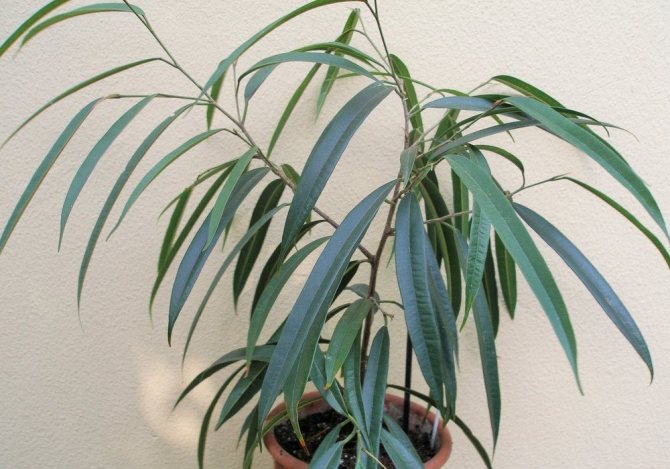

If you plan to place it in other places, then consider the following features:
- lack of light will lead to loss of color in the leaves;
- direct sunlight will provoke burns, so when placed on the south side, be sure to shade it;
- the plant does not tolerate a change of place, so immediately choose a location for it, taking into account potential growth;
- the flower should not suffer from drafts.
Temperature regime
In addition to light, ficus Benedict also loves warmth. In summer, he will be comfortable at + 22 ... 24 ° С, and in winter, the minimum allowable limit is + 16 ° С.
Important! When growing a flower, remember a simple rule: the warmer it is in the room, the more light it needs, and the cooler, the shorter daylight hours it needs.
By itself, a change in air temperature does not affect the ficus too much, but a sharp drop in soil temperature is critical for it. It is highly discouraged in summer to put the pot near air conditioners, and in winter, when heating devices are in operation, the ficus should be away from them.
He loves the plant and fresh air: regular ventilation of the room will benefit him.
Air humidity
The moisture level is not very important for the Ali variety, but it is better to keep it at 50-70% if possible.
On hot summer days, it will not interfere with periodic spraying with warm, settled water or wiping the foliage with a damp sponge. It is great if there is an opportunity to place a household humidifier in the room at this time.
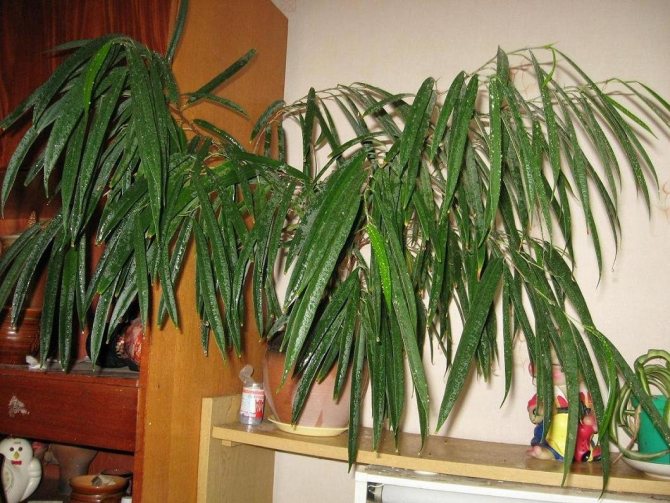

Benedict's transplant
When the willow ficus grows up and the pot becomes too cramped for it, there is not enough earth for the roots, it dries up quickly, it's time to replant the plant. The pot for Benedict is chosen a couple of centimeters larger than the previous one.
Young plants need an annual transplant, and 4-5-year-olds can be relocated every two years or less.
When transplanting (reloading) to old soil add fresh.
Before transplanting, the plant is watered abundantly.... Be sure to examine the roots of the ficus. Rotten or damaged parts are removed. The bottom of the container is laid out with expanded clay or pebbles.
At the end of the process, the new settler is again watered at the root. If necessary, the migrant is reinforced with a support. Adult specimensgrowing in large containers, only require renewal of the top layer of the earth without replanting... Resettlement of green pets is carried out in the spring-summer season. In winter, plants are not disturbed.
The older the plant, the less it needs to be disturbed.... It is best to replace the top drying layer of the earth with a new one. Old plants cannot be transferred to a new location.
Ficus varieties Binnendijka
Amstel King
A variety that is distinguished by a characteristic spherical crown, a tall trunk and solid dark green leaves that reach 6 cm in width.
Amstel Queen
A variety with monochrome leaf blades that are wider than Amstel King but narrower than Ali's ficus.
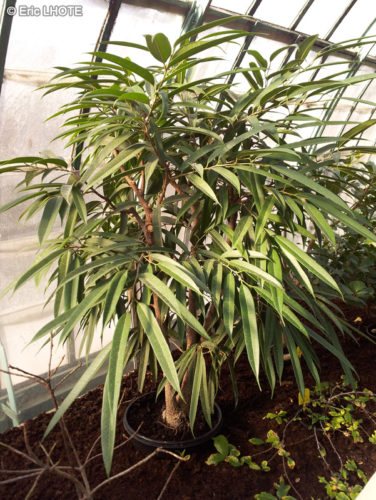

Amstel Gold
A view with variegated foliage - spots of various shapes of various shades of green are located on a light yellowish-green background.
Is bonsai suitable for formation?
It is not difficult to give the crown of willow ficus the desired shape, it is only necessary to cut the branches regularly in the spring-summer period.
There are several options:
- two-tier bole - divide the crown into 3 levels, remove the branches in the middle, and give the lower and upper spheres;
- a simple stem - leave 5 central stems, make the lateral ones look like a ball, pinch the top.
Expert opinion
Mokhov Andrey Petrovich
Graduated from KubSAU specialty: agronomy
Pruning should be done with a sterile pruning shears, sprinkle the cuts with chopped charcoal or activated carbon.
You can also plant 2 young specimens in 1 flowerpot and intertwine their trunks.
Ficus and crown appearance
Ficus Ali is a hybrid of Binnendeyka ficus, its mini-copy, artificially bred for indoor cultivation. This is an ornamental tree. Its progenitor at home in the Indonesian forests grows up to 25 meters. And the selection tracing paper is miniature - her average height is 2 meters.
Ali's (also known as Benjamina's) leaves are dark green or variegated, with numerous veins, depending on the variety. Shaped like willow or oleander leaves. They are glossy, long and narrow. The trunk is high, flat, with dark bark. Drooping branches, more reminiscent of a willow.
As the tree grows the lower leaves die off, exposing the trunk... An adult ficus is a small tree with a rounded crown and a long trunk.
Shaping the trunk and crown shape of a tree is easy... It is enough to cut off the shoots in the spring to preserve the compactness of the specimen and the splendor of its crown. A stunning effect can be achieved and other methods.
Crown formation options
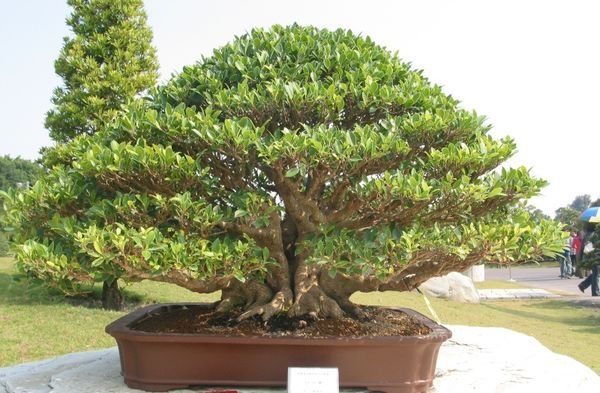

Shape a ficus crown with imagination!
Simple bole
In a young plant, the lateral shoots are first cut off., allowing only five central ones to grow.Then pinch the top of the most important of them, and the side shoots are cut in the shape of a ball. The trunk will need a support for some time, which can then be removed.
Bunk bole
Plant share three levels... On the top and bottom, trimming is done in the form of a ball. And in the middle part, side shoots are removed.
Ficus braiding
Two or three small cuttings are planted in one pot. From two, a spiral is obtained, and from three, a pigtail. The weave must be loose to allow the tree to grow. Excess leaves and shoots are removed at the same time.
Shape the crown it is impossible during the dormant period of the plant from October to February... You need to cut off the shoots with a sharp tool, while avoiding hemp. Slightly moisturize the cut sites for the first time.
Signs and superstitions
Amstel ficus is mentioned in Asian and Slavic culture. Moreover, this flower appears in diametrically different light, so superstitious people have to make a difficult choice. In Asia, ficus is considered a useful plant that brings good luck and wealth to the home. On its basis, alcoholic infusions are made to relieve inflammatory processes. In Slavic culture, this flower is considered a lovebird, driving men out of the house.
In any case, Ali's stately ficus will be a wonderful decoration for the home. Its sprawling high crown makes it an independent green element of the interior. For flower growers, it will be a godsend for creativity, since pruning and shaping branches are exciting activities. Compliance with simple rules of care will allow you to admire a beautiful noble flower for many years.
Growing difficulties
Problems with the growth and development of ficus Ali arise as a result of improper care.
- Yellowing of foliage, loss of turgor pressure - lack or, conversely, excess of light.
- Blackening of leaf blades and gradual dying off - differences in room temperatures with an amplitude of at least 7 ° C.
- Black dots and spots on the back of the plates indicate infection with a fungal infection. We are talking about diseases such as cercospora or anthracnose. The last of them looks like a reddish bloom covering the bark of a diseased tree. If the necessary measures are not taken in a timely manner, the plant can die or lose part of the leaves.

